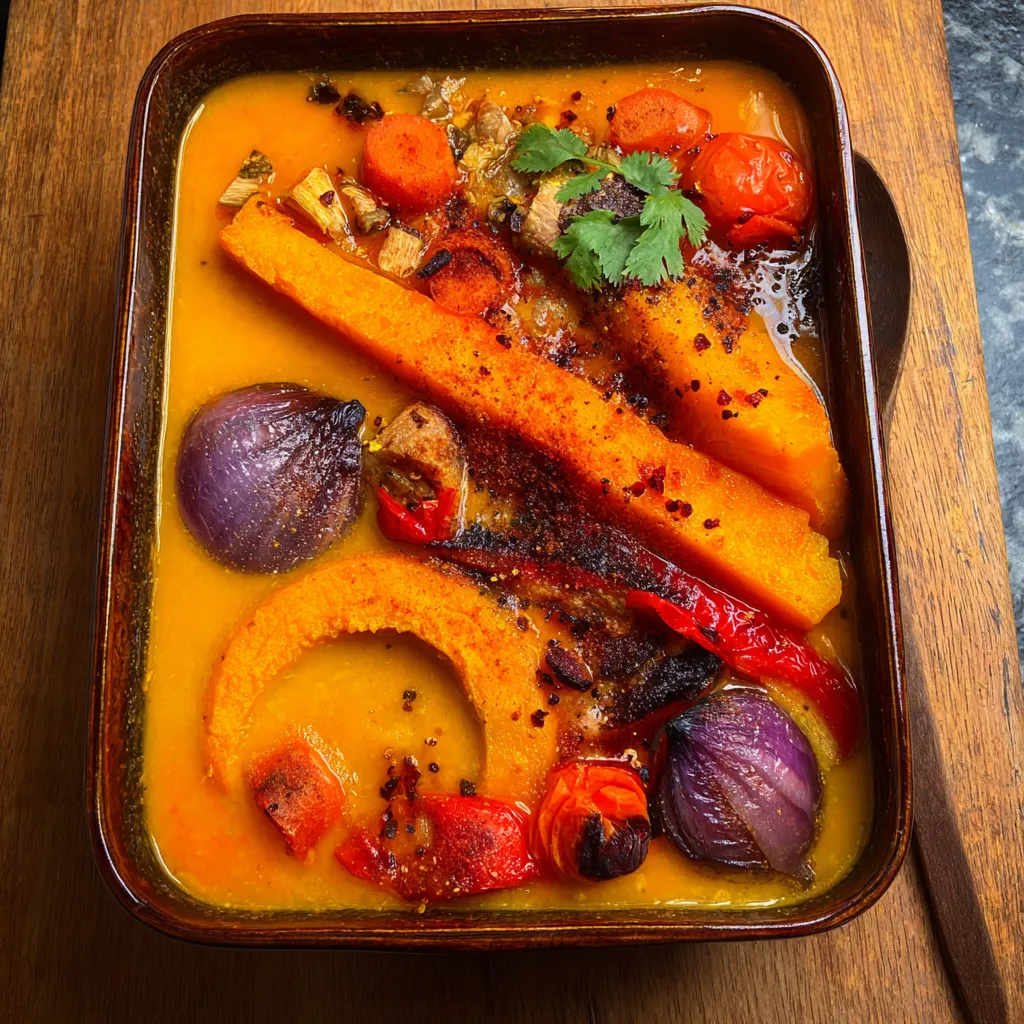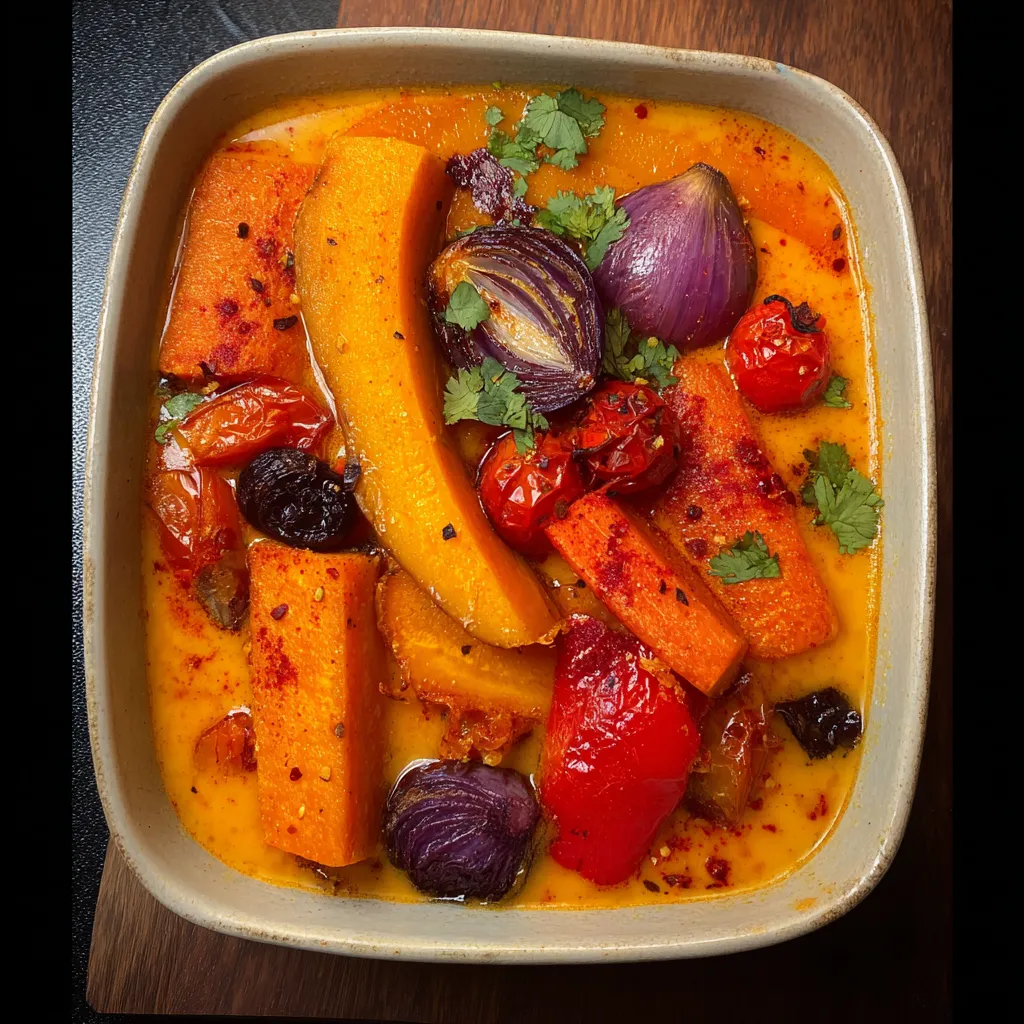 Bookmark
Bookmark
There is nothing more comforting on a chilly fall evening than a bowl of roasted butternut squash soup. With just a handful of nourishing ingredients, this soup transforms into a creamy, rich meal that feels both wholesome and indulgent. I always reach for this recipe as soon as squash arrives at my farmer’s market, and it fills my kitchen with cozy aromas that just say autumn.
When I first tried roasting the squash for soup instead of just boiling it, I was amazed at how much sweeter and richer it tasted. My family requests this constantly as soon as the leaves start to turn.
Ingredients
- Butternut squash: Brings sweetness and body to the soup. Pick a squash that feels heavy for its size and has a matte skin for ripeness
- Coconut milk: Adds creaminess and a hint of sweetness. Choose full fat for the richest soup
- Red onions: Offer mild sweetness and savory base notes. Look for firm onions without soft spots
- Carrots: Balance the squash’s sweetness and give extra color. Bright orange and firm carrots work best
- Bell peppers: Provide a subtle smokiness and extra depth. Red or orange are sweetest
- Garlic: Infuses the soup with warmth and umami. Fresh, full heads ensure maximum flavor
- Tomatoes or cherry tomatoes: Brighten up the soup with natural acidity. Ripe and vibrant tomatoes are best
- Vegetable broth: Keeps the soup light and savory. Opt for a low sodium version if you want to control the salt
- Fresh ginger: Adds a gentle kick and warmth. Use a plump, smooth piece if possible
- Olive oil: For roasting and enhancing flavors. Go for a high quality extra virgin for best taste
- Fresh cilantro: Brings a fresh, herbal finish to the soup. Look for full, bright-green leaves
- Black pepper: Wakes up the other spices and adds a gentle heat
- Ground cumin: Gives subtle earthiness and depth
- Paprika: Smoky and sweet, this layers on flavor
- Dried thyme: Herbaceous and woodsy. Perfect for fall dishes
- Dried rosemary: Adds a piney, fragrant note
- Chili oil: Optional but brings a little heat and color
Step-by-Step Instructions
- Preheat the Oven:
- Set your oven to three hundred ninety degrees Fahrenheit or two hundred degrees Celsius so the vegetables cook evenly and caramelize without burning
- Prepare the Vegetables:
- Peel and chop the butternut squash for quicker cooking or cut it in half if you want a deeper roasted flavor. Peel the onions and cut them into thick wedges. Dice the carrots. Core and slice the bell peppers. Slice the top off the garlic heads so each clove is exposed. Chop the tomatoes or cut cherry tomatoes in half
- Season the Vegetables:
- Scatter the vegetables over a large baking sheet. Sprinkle with black pepper ground cumin paprika dried thyme and dried rosemary. Drizzle generously with olive oil and toss with your hands to coat every piece. If using halved squash brush its surface with olive oil
- Roast the Vegetables:
- Cover with foil and roast for about one and a half hours until the veggies are golden soft and caramelized. For smaller chopped pieces start checking at forty five minutes since they will cook more quickly. Lift the foil in the last ten minutes so everything gets a little more color on the edges
- Blend Until Smooth:
- If you roasted the squash in halves let it cool enough to handle then scoop out the flesh. Transfer all roasted veggies to a large blender. Add the vegetable broth and ginger if you like. Blend until completely smooth and creamy for the best texture
- Warm and Finish:
- Pour the blended soup into a large pot and set over medium heat. Stir in your coconut milk and let it simmer for a couple of minutes so everything melds. Taste and adjust seasonings if needed
- Garnish and Serve:
- Ladle into bowls. Swirl in more coconut milk fresh cilantro and a dash of chili oil for a pretty finish and extra flavor

One of my favorite parts is the way fresh ginger brightens up every spoonful without overpowering the other flavors. My kids usually gather by the oven as the squash roasts and we end up snacking on the caramelized bits even before blending everything together.
How to Store Leftovers
This soup keeps beautifully in the fridge for up to four days. Let it cool completely before storing in airtight containers. You can also freeze it for up to three months. I recommend thawing overnight in the fridge and reheating gently on the stove while stirring to restore its creamy texture.
Ingredient Swaps
If you cannot find butternut squash use kabocha or acorn squash for a similar sweetness. Full fat coconut milk tastes best but almond or oat milk can be used if you want a lighter soup. Leeks work well in place of onions for a milder flavor and parsley can be swapped for cilantro in a pinch.
Serving Suggestions
A scoop of cooked quinoa or brown rice transforms this soup into a hearty meal. Serve with toasted pumpkin seeds or homemade croutons on top for crunch. If you love a little contrast add a spoonful of plain yogurt or vegan sour cream just before serving.
The Roots of Butternut Squash Soup
Hearty squash soups have been loved for centuries in both American and global kitchens. Roasting the vegetables as in this recipe is a modern touch that comes from a desire to build deeper caramelized flavors and reduce stovetop tending time.
Common Questions About This Recipe
- → How do I achieve extra creaminess in the soup?
Roast the squash until it's very soft and caramelized, then blend thoroughly with coconut milk for the silkiest result.
- → Can I make this dish ahead of time?
Yes, prepare and store the soup in an airtight container in the refrigerator for up to 4 days. Reheat gently before serving.
- → What can I use instead of coconut milk?
For a similar creamy texture, use cashew cream, oat milk, or dairy cream as alternatives to coconut milk.
- → How can I add more spice or heat?
Increase chili oil, add extra black pepper, or include a pinch of cayenne pepper when seasoning the vegetables before roasting.
- → Is the soup suitable for freezing?
Yes, cool completely and freeze in portions. Thaw and heat gently, stirring well to restore its creamy texture.
